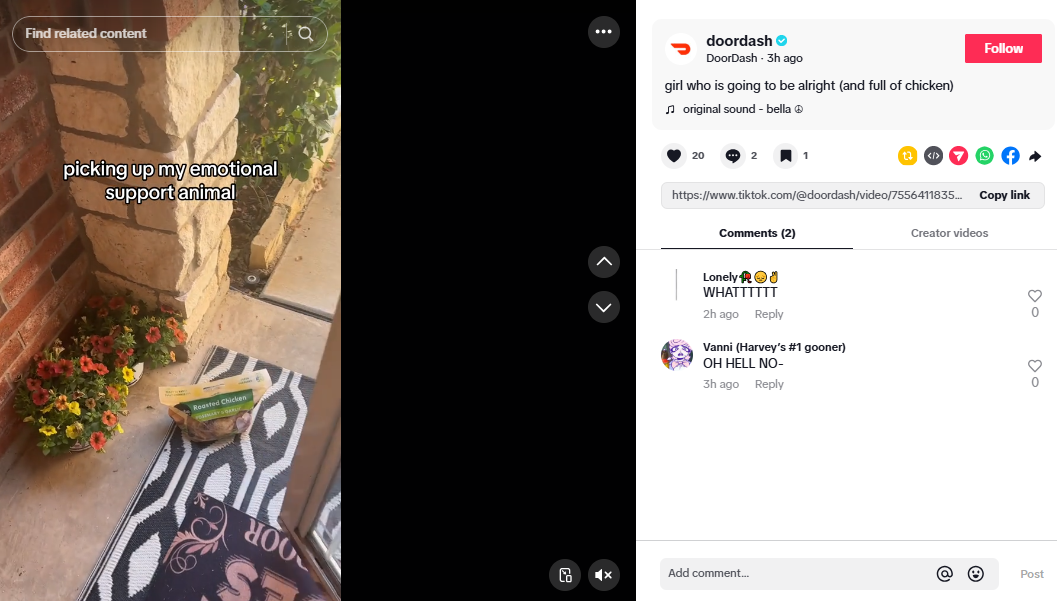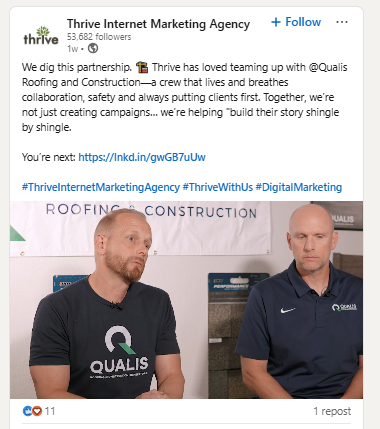
Social platforms move fast, and attention spans move even faster. A static image might stop someone for a second, but video has the ability to hold their focus and lead them toward action.
That's why 69% of marketers create social media videos, many of which are paid ads. Besides displaying the product, these videos also build a narrative and an emotional connection that lingers long enough to influence decisions.
When people scroll, they aren't particularly searching for ads. But they do enjoy entertainment and stories. A well-executed video ad blends into that rhythm, as it grabs interest without being jarring.
In this guide, we discuss the role of paid social video ads in your broader marketing strategy. We also share tips on using video for paid campaigns to increase conversions.
People spend more time watching short clips than scrolling past images. Brands have noticed. In fact, the time people spend watching social video content is forecasted to increase to 57 minutes (from 52 minutes in 2024) by 2028.
Keeping this trend in mind, the majority of brands are now using video in their marketing mix. Consumers also want more videos from the brand. That level of demand changes what audiences expect when an ad appears in their feed.
Platform engines reflect that shift. Major social media platforms rank content that sparks sustained engagement, and they are reworking product logic to favor native video formats. For example, Meta has announced that Facebook will soon classify all new video uploads as Reels.
Similarly, Instagram is testing interfaces that open directly into short-form video, especially when you land on someone's profile. TikTok already opens right into a video ad in most cases. These moves push video into more prominent placements and increase the chances that paid creative is seen at scale.
For advertisers, the outcome of this shift is concrete. Interactive and product-focused videos routinely lift purchase intent and lower hesitation among first-time buyers.
On commerce-first platforms like TikTok, in-feed shopping tools make it simple for viewers to act inside the app, turning passive viewing into immediate transactions. So, it's important that you invest in paid social video ads to fit into this modern advertising landscape.
Now that you understand the importance of a solid Instagram, TikTok, or Facebook video ads strategy, let's discuss how to create one. We've covered the instructions in steps to make them easier to follow.
The success of paid social video ads comes from matching the right format to the right goal. Every type of video serves a specific purpose along the buyer’s journey. When you understand how each format functions, you can align creative choices with your desired results.
Short-form videos are perfect for top-of-funnel campaigns. Their strength lies in grabbing attention in seconds and leaving a memorable impression.
For example, a fashion retailer can show a 15-second outfit change Reel on Instagram, while a food delivery app could highlight a two-step ordering process on TikTok. These clips don’t overload the viewer, and focus on one sharp message that pushes the scroll-stopper moment into a click.
Explainer videos help when a product or service needs more context. They answer the unspoken question, “How does this work for me?” For example, a fintech company might release a 30-second animated explainer to simplify how its app tracks spending. That's exactly what Goodbudget has done in this video.
SaaS brands often rely on screen recordings that walk through a feature in action, making technical concepts feel approachable. Since these videos reduce confusion, they move viewers closer to a confident decision.
Trust is a must in paid campaigns, and nothing builds it faster than hearing directly from real people. Consumers are also interested in seeing user-generated content (UGC) since it's from people like them and not the brand itself. Nearly 82% of consumers state that they are more inclined to purchase if a brand uses UGC in their marketing material.
For example, a skincare brand can feature quick clips of customers sharing visible before-and-after results, or a travel company might run ads with authentic footage submitted by vacationers.
Rare Beauty does this quite well. They share UGC from regular customers on their Instagram page to show their products being used by people other than models and influencers.

These videos act as social proof. They're credible voices that confirm your message without overselling.
Sometimes one video isn’t enough to tell the whole story. Carousel or multi-part video ads allow you to show a whole sequence.
Take the example of an electronics retailer. They could display a series of clips highlighting different features of a laptop, such as design, performance, and battery life. Each video covers one aspect of the product and doesn't overwhelm the viewer.
This layered approach keeps viewers engaged longer and addresses multiple touchpoints in a single campaign. Plus, you can target videos to different pain points.
Great video ads aren’t built on visuals alone; they succeed because of the story they tell. Paid social campaigns move quickly, so your ad has only a few seconds to capture interest. That’s why the opening three seconds matter most.
A clear hook, like a surprising stat, a relatable pain point, or a bold visual cue, stops the scroll and gives your audience a reason to stay. Without it, the ad blends into the feed and disappears just as fast.
Once attention is secured, the narrative must carry momentum. People connect with stories that mirror their experiences and emotions. Instead of listing product features, shape the ad around a challenge your audience faces and show how life looks after the solution.
The final step is to guide viewers toward action. A strong call-to-action should feel like a natural extension of the story, not a hard break.
Don't abruptly say “Buy now.” Position the CTA as the next logical step, such as “Start your first workout today” or “See how others achieved results.” Such phrasing reduces friction and makes conversion feel effortless.
Brands often work with a video marketing agency or a video production company to refine this balance of creative and technical detail. These agencies specialize in everything from TikTok Reels short-form video production to longer YouTube brand content. So, they can assist you in creating ads that support deeper brand storytelling.
Not all platforms treat video the same way, as each has its own audience habits, placement styles, and performance signals. You must adapt content to the strengths of each channel to make the most of video for paid campaigns.
Here's how.
A strong Facebook video ads strategy recognizes that these platforms reward immersive, mobile-first content. Reels and Stories are full-screen experiences, so vertical formats are a must. For example, Areej Global uses an in-feed video ad to show its products.
Quick captions, strong visuals, and audio designed for mobile keep users watching. Meanwhile, in-feed ads should seamlessly fit into organic content.

It also helps to combine different types of ads. For example, a clothing brand might use Stories to spotlight a time-sensitive offer while relying on in-feed ads for longer lifestyle clips that show the product in context. Combining placements gives your paid social video ads reach and depth.
On TikTok, your video ads must feel less like advertising and more like entertainment. Brands that succeed here lean into the platform’s culture, which is short, relatable, and trend-driven storytelling.
For example, a food delivery service could use a trending sound to show the moment food arrives at the door. DoorDash does a stellar job of it, while also incorporating humor or pop culture references in some of its posts.

TikTok’s algorithm favors relevance over polish, so even lower-production ads can convert when the message resonates. Keep it concise and aligned with the rhythms of the feed.
For B2B brands, LinkedIn offers space for credibility and thought leadership. Here, video for paid campaigns should emphasize value, insights, or professional impact.
Let's say you're an HR tech company. You can post a video ad showing a client's success story or highlight key industry data in a 30-second explainer. For example, Thrive Marketing posts videos of its new client relationships. These videos can be turned into social ads and targeted to stakeholders in the same industry to attract them.

Subtitles are a must since many users watch without sound. The tone should remain professional, but not stiff, showing expertise while still feeling approachable.
YouTube’s long-form nature makes it ideal for storytelling that goes deeper. Pre-roll ads must hook attention instantly since viewers are seconds away from skipping. However, mid-roll placements work better with a narrative that has already built curiosity.
For example, a software company could run a pre-roll with a clear product hook, then use longer mid-roll ads to show real-world use cases. This pre-roll ad from Monday.com is a good example.
Campaigns often pair YouTube ads with remarketing audiences to reinforce messages across multiple touchpoints.
You only get high-converting video ads if you target them to the right audience. To get there, start with audience segmentation using demographics, interests, and behaviors to match viewers with the right message. For example, top-of-funnel awareness clips work well for broad audiences, while marketing funnel videos for specific needs are best for warmer segments.
You can retarget the videos to push performance even further. Custom audiences allow you to reach people who’ve already engaged with your content, which makes it easier to guide them through the next step.
For example, if you're a software company, you can target viewers of a product demo with a shorter testimonial clip. Show them how your clients have used your product to see success. Platforms like Facebook and LinkedIn make this approach easy to scale.
Placement testing rounds out a strong video marketing strategy. You can compare feed ads, Stories, Reels, and in-stream placements to identify where conversions originate.
If you're struggling to do this in-house, a results-driven video agency can help build a content system for business campaigns. Since these partners specialize in full-funnel video marketing approaches, their mix of video content ideas for business and smart placement strategies can help you scale paid ads with video effectively.
Our video distribution playbook is a good resource in this regard.
.gif)
If you're running paid social video ads without clear video marketing analytics, you're basically steering without a compass. It's not going to get you anywhere.
You need to measure engagement metrics, such as likes, shares, comments, and view counts, to see how well your content captures attention. They’re useful for gauging resonance, but they don’t always signal if a campaign is driving sales or sign-ups. That’s where conversion metrics become important.
Track cost per view to understand efficiency, then look deeper at click-through rate (CTR) and cost per acquisition (CPA). CTR shows how well your ad motivates action, while CPA connects spend directly to business results.
For example, a strong Facebook video ads strategy might deliver a high view rate, but if clicks and conversions stay low, the creative or targeting may need refinement.
After collection, it's time to interpret this data. High engagement with low conversions could mean your storytelling entertains without guiding action. In comparison, strong conversions but weak engagement may signal a narrow reach, limiting scale.
Analyze both sides to refine video for paid campaigns and adjust creative, audience segmentation, or placement to improve return on spend. If you need expert assistance, a results-driven video agency like INDIRAP can be your partner in scaling paid ads with video.
Video on social platforms has shifted from a trend to the centerpiece of results-driven campaigns. The ability to connect with audiences quickly, hold attention, and guide them toward action is what separates casual content from true conversion tools.
Brands that use video for paid campaigns are likely to see scrolls converting into sales. INDIRAP, as your dedicated video production company Chicago, can help you accomplish this by bringing together strategy, production, and distribution under one roof.
With over 11,000 videos delivered and more than 900 clients worldwide, INDIRAP knows how to design high-converting video ads that move people through the funnel. Book a free, no-obligation Discovery Call today to discuss your video ads strategy in detail.